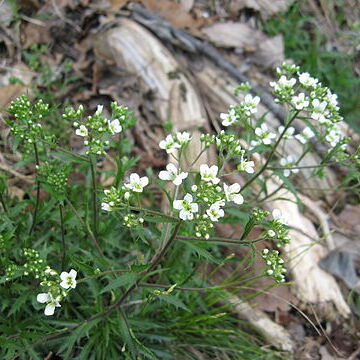Perennials; caudex branched (well-developed, with persistent leaf bases); not scapose. Stems unbranched proximally, pani-culately branched distally, 0.7-3.8(-5) dm, pubescent proximally, trichomes short-stalked, 2-4-rayed, 0.1-0.6 mm, sometimes with simple ones, 0.4-0.8 mm. Basal leaves rosulate; petiolate; petiole (to 2 cm), ciliate (trichomes simple, 0.3-0.5 mm); blade oblanceolate, (0.7-)1-5.5 cm × 2-8 mm, margins dentate, surfaces pubescent with short-stalked to subsessile, 3-or 4-rayed trichomes, 0.1-0.5 mm, adaxially sometimes also simple, 0.4-1.3 mm. Cauline leaves (5-)7-15(-21); sessile; blade ovate to oblong or elliptic to lanceolate, margins usually coarsely dentate or serrate, rarely subpinnatifid, surfaces pubescent as basal. Racemes 9-28-flowered, ebracteate, paniculate; rachis not flexuous, pubescent as stem. Fruiting pedicels horizontal to divaricate-ascending, straight, (4-)6-12 (-15) mm, pubescent, trichomes 2-4-rayed. Flowers: sepals oblong, 2.5-3 mm, pubescent, (trichomes simple and subsessile, 2-4-rayed); petals white, spatulate, 4-6 × 1.5-2.5 mm; anthers oblong, 0.5-0.6 mm. Fruits narrowly oblong to elliptic or oblong-lanceolate, often strongly twisted, flattened, 5-11 × 1.5-2.2 mm; valves pubescent, trichomes subsessile or sessile, 2-4-rayed, 0.07-0.3 mm; ovules 4-10(-12) per ovary; style (1)1.5-3(-4) mm, (sparsely pubescent). Seeds oblong, 1.2-1.8 × 0.6-0.9 mm. 2n = 16.
More
Mat-forming perennial with a branching caudex; basal lvs oblanceolate, 1–5 cm, tapering to a long slender base; cauline lvs scattered, lanceolate to oblanceolate, both types sharply acute and with a few sharp, slender, divergent teeth; flowering stems 1–4 dm, thinly hairy, often branched above to form an eventually open and rather diffuse infl; pet white, 6–7 mm; mature pedicels thinly stellate, rather widely ascending, to 15 mm; frs elliptic to narrowly oblong, 4–10 mm, often twisted, thinly stellate; persistent style 1.5–3 mm; 2n=16. Dry mt. woods; Md. and Va. to W.Va., e. Ky., N.C., and Tenn. Apr., May.

